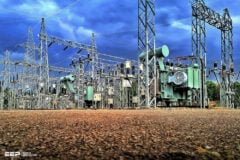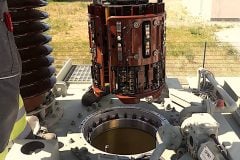
Today the production of transformers is characterised by a large variety of designs, manufactured in relatively short batches to meet the demands of a variety of customers with ever-changing expectations. Of course, fluctuations in commodity prices have a significant effect.
The designer has a certain choice of solutions which can be applied in order to build a transformer with expected rated losses. It is possible to use, for instance, different magnetic materials or change the proportions between the level of magnetic induction and current density. It is, however, important from the point of view of the manufacturer that the transformer with expected parameters will be designed in an optimum way.
It is also possible to vary the ratio of copper to steel quantities. According to an old rule of thumb within the transformer industry, the production cost optimum lies somewhere around a ratio of steel to copper usage of 2:1.
However, it is a fairly flat optimum and, of course, varies with the price ratio of steel to copper. Independently of this, it should be taken into consideration that the operating properties of the transformer also vary when the shares are varied, especially with respect to losses:
Holding the current densities in the windings and the magnetic flux density in the core constant, the loss per kilogram of copper or steel, respectively, will be more or less constant. Thereby a transformer designed according to this philosophy, but with more iron and less copper, tends to have higher iron losses, and one with more copper and less iron will have higher copper losses. But this does not mean that skimping on copper and steel pays off! Rather, enhancing the core cross-section while keeping the number of turns constant will reduce core losses, and enhancing the copper cross section while keeping the core cross section constant will reduce copper losses.
The progress in the scope of calculation techniques allows for optimisation to get a precise model of the transformer geometry, taking into account the actual core cross-section and the location of windings. It allows precise calculation of the transformer parameters. Manufacturers have many methods of design optimisation at their disposal which may be used in solving the issues in question.
At today’s commodity prices (low loss magnetic steel 2 500 – 3 000 € / tonne, copper 6 000 – 7 000 € / tonne) the indicative transformer price for AC’ class 100 kVA typical distribution transformer is around 3 000 €, 400 kVA is around 7 000 € and 1 000 kVA around 12 000 €.
The price / rating characteristics can be roughly described as:

where:
C1 – is cost of transformer “1”
C0 – is cost of transformer “0”
S1n – is rated power of transformer “1”
S0n – is rated power of transformer “0”
x – exponent (cost factor)
The X factor is about 0.4 to 0.5. For more efficient units this factor has a tendency to increase up to 0.6 or even higher. Dry type transformers representing rated losses specified by HD 538 standard are usually a few percent lighter than oil transformers (as they do not contain oil) but, because of the more costly manufacturing process, they are about 10% to 30% more expensive than CC’ oil-filled machines.
Because of some differences in design, particularly of magnetic circuit, no-load losses of dry transformers are substantially higher than in oil transformers. Thanks to optimisation efforts and technology improvements, there is an area for transformer manufacturing cost reduction. Commodity prices have gone up for the last few years and have outweighed the cost-reducing effect of optimisation and technological improvements.
The cost of active materials in typical transformers increased by more than 50% between the years 2003 and 2007. In these conditions transformer design optimisation can bring around 5% savings in manufacturing cost. This effect is better in less efficient machines.
Please note that, when the price of both active materials (magnetic steel and winding material) increases in similar proportion, the optimisation brings only marginal savings in manufacturing cost, when the same loss levels are specified. So manufacturers rather prefer to agree certain capitalisation based formula when optimisation of transformer may bring some savings in manufacturing cost.
Today, the cost active materials in an average distribution transformer represents about 50% of the transformer total price; taking all materials into account increases this to 70% of the total price.
Let’s take the example of a typical medium size distribution transformer
Efficiency improvement today by reducing no-load losses adds to the cost by about 0.3% to 0.7% for 1% loss reduction in the area of moderate losses (between A’ and C’ level) and from 0.7% (close to C’) to 1.4% in area of very low losses (more than 20% below C’). For load losses, this proportion is higher, even at smaller load loss reduction and ranges from 0.6% to 1%.
When we start to reduce load loss in the area of level C minus 15% (new Ak level) this cost may increase to 1.6%.
Very roughly, if both losses are reduced at the same time, the cost should theoretically be higher (if noload losses are reduced by adding more steel, the core becomes wider and requires longer conductor path resulting in increase of resistance and load loss, when load losses are reduced by increasing conductor cross-section the core becomes larger and requires more steel) but in fact this effect is almost negligible until a certain level of both losses. Beyond that, reducing both losses at the same time results in increasing suboptimum and going further towards both reduction extremes becomes extremely expensive and absolutely impractical.
It is, however, worthwhile mentioning that load loss reduction by increasing the amount of conductor material is not necessarily the most cost-effective measure. As already mentioned, to reduce load losses by design optimisation it is possible to reduce the amount of copper but change other transformer parameters e.g. adding more or higher grade magnetic steel.
As a very general comparison, ten years ago, amorphous transformers were more expensive than the European average transformers (with AC’ losses) by a factor of 2 or more. Today, this proportion has reduced to a factor of 1.5 or less.











Hey my is Edwin Idehen I’m wondering how much would a high quality transformer that can transform over 1000mgw?
hello startup
am here a transformer manufacture and specialist of manufacturing plant setup for transformer am having my own factory at jammu
if any is interested to involve in transformer business then contact me
pls dont call me as fake. if u really want to start then call me
definitely i will help you
my no. +917027891346
feel free to talk with me
thank you
vikas
T.M&C
what is the price of 500 & 300 kva transformer
the price of transformer as at 2016
Dry Type transformers use air as the cooling medium. Oil Type transformers are considered a potential fire and safety hazard. Oil Type transformers require the development and maintenance of reliable fire safety and extinction procedures
Dry Type Transformers can be located closer to the load unlike oil transformers which require special location and civil construction for safety reasons. Locating the transformers near the loads may lead to savings in cable costs and reduced electrical losses.
Oil Type transformers may require periodic sampling of the oil and more exhaustive maintenance procedures.
However, though dry type transformers are advantageous, they are limited by size and voltage rating. Higher MVA ratings and voltage ratings may require the use of oil Transformers alone.
For outdoor applications, oil filled transformers are cheaper than dry types.
11kv transformer 315 kva